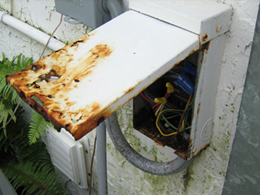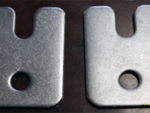-
Recent Posts
- Nema Enclosures Mfg. awarded ISO 9001:2015 re-certification as a Seal of Quality Standard
- NEMA 3RX Rating Now Offered
- NEMA ENCLOSURES MFG. RECEIVES ISO 9001:2015 CERTIFICATION
- Learn about our ATEX & IECEx Ex e Value Added Features and Accessories
- Motor Control Center (MCC) Drop-Over Custom Enclosures
Archives
- May 2021
- February 2021
- July 2018
- October 2017
- September 2017
- April 2017
- January 2017
- December 2016
- March 2016
- February 2016
- October 2015
- August 2015
- July 2015
- May 2015
- October 2014
- August 2014
- June 2014
- April 2014
- March 2014
- February 2014
- September 2013
- August 2013
- July 2013
- June 2013
- May 2013
- April 2013
- February 2013
- January 2013
- December 2012
- November 2012
- October 2012
- September 2012
- March 2012
- February 2012
- August 2011
- May 2011
What’s the difference between 304 and 316 stainless steel?
The simple answer is 304 contains 18% chromium and 8% nickel while 316 contains 16% chromium, 10% nickel and 2% molybdenum. The molybdenum is added to help resist corrosion to chlorides (like sea water and de-icing salts). I found the brochure Stainless Steel for Coastal and Salt Corrosion Applications to be very helpful as a general reference for using stainless steel in our area.
Click here to view our 304 vs 316 stainless steel infographic!
The last thing you need is your outdoor electrical enclosure rusting out on you.

 Not only is there the danger of exposing all your critical electrical components inside, it could cost you a lot to replace when it shorts out. We’re talking parts damage and replacement, repair costs including labor and downtime. I’ve seen some real horror shows when enclosures rust out. It’s not pretty. The good news is we have a simple cost effective solution. We found that by using 316 stainless steel instead of 304 stainless steel on an outdoor enclosure that will be exposed to the elements (like on an oil rig, for example) not only increases the life span of the enclosure but it is much safer to be around.
Not only is there the danger of exposing all your critical electrical components inside, it could cost you a lot to replace when it shorts out. We’re talking parts damage and replacement, repair costs including labor and downtime. I’ve seen some real horror shows when enclosures rust out. It’s not pretty. The good news is we have a simple cost effective solution. We found that by using 316 stainless steel instead of 304 stainless steel on an outdoor enclosure that will be exposed to the elements (like on an oil rig, for example) not only increases the life span of the enclosure but it is much safer to be around.
How do you know you’re getting 316 stainless steel instead of 304 stainless steel?
 You can’t tell just by looking at it. There’s no visible difference between two identical pieces of sheet metal, a polished or grained the exact same way. That’s why you need a material test report (MTR) of the actual material to validate it as being 304 or 316. We make sure we get one with every shipment we receive at Nema Enclosures so that we can assure our customers that the enclosure and its parts are constructed of the exact stainless steel material, as specified and ordered. Some small parts such as clamps and mounting feet, constructed of 316 stainless steel are specifically marked, in this case a number 6 within a circle, as shown in the photo above.
You can’t tell just by looking at it. There’s no visible difference between two identical pieces of sheet metal, a polished or grained the exact same way. That’s why you need a material test report (MTR) of the actual material to validate it as being 304 or 316. We make sure we get one with every shipment we receive at Nema Enclosures so that we can assure our customers that the enclosure and its parts are constructed of the exact stainless steel material, as specified and ordered. Some small parts such as clamps and mounting feet, constructed of 316 stainless steel are specifically marked, in this case a number 6 within a circle, as shown in the photo above.
What is Type 304 stainless steel and what’s it used for?
 Type 304, with its chromium-nickel content and low carbon, is the most versatile and widely used of the austenitic stainless steels. Its alloys are all modifications of the 18% chromium, 8% nickel austenitic alloy. Type 304 proves to be resistant to oxidation, corrosion, and durability. All provide ease of fabrication and cleaning, prevention of product contamination offer a variety of finishes and appearances. Type 304 stainless steels are used in corrosion resistant electrical enclosures, auto molding and trim, wheel covers, kitchen equipment, hose clamps, exhaust manifolds, stainless hardware, storage tanks, pressure vessels and piping.
Type 304, with its chromium-nickel content and low carbon, is the most versatile and widely used of the austenitic stainless steels. Its alloys are all modifications of the 18% chromium, 8% nickel austenitic alloy. Type 304 proves to be resistant to oxidation, corrosion, and durability. All provide ease of fabrication and cleaning, prevention of product contamination offer a variety of finishes and appearances. Type 304 stainless steels are used in corrosion resistant electrical enclosures, auto molding and trim, wheel covers, kitchen equipment, hose clamps, exhaust manifolds, stainless hardware, storage tanks, pressure vessels and piping.
What is Type 316 stainless steel and what’s it used for?
 Type 316 stainless steel is an austenitic chromium-nickel stainless and heat-resisting steel with superior corrosion resistance as compared to other chromium-nickel steels when exposed to many types of chemical corrodents such as sea water, brine solutions, and the like. Since Type 316 stainless steel alloy contains molybdenum bearing it has a greater resistance to chemical attack than 304. Type 316 is durable, easy-to-fabricate, clean, weld and finish. It is considerably more resistant to solutions of sulfuric acid, chlorides, bromides, iodides and fatty acids at high temperature. Stainless steels containing molybdenum are required in the manufacture of certain pharmaceuticals in order to avoid excessive metallic contamination. The bottom line is that Type 316 stainless steel costs a little more upfront but you could save a whole lot on the back end – especially if your enclosure is going to be used outdoors. Something worth keeping in mind when you’re designing your next enclosure. To place an order or if you have questions please contact us today at 713-921-2233.
Type 316 stainless steel is an austenitic chromium-nickel stainless and heat-resisting steel with superior corrosion resistance as compared to other chromium-nickel steels when exposed to many types of chemical corrodents such as sea water, brine solutions, and the like. Since Type 316 stainless steel alloy contains molybdenum bearing it has a greater resistance to chemical attack than 304. Type 316 is durable, easy-to-fabricate, clean, weld and finish. It is considerably more resistant to solutions of sulfuric acid, chlorides, bromides, iodides and fatty acids at high temperature. Stainless steels containing molybdenum are required in the manufacture of certain pharmaceuticals in order to avoid excessive metallic contamination. The bottom line is that Type 316 stainless steel costs a little more upfront but you could save a whole lot on the back end – especially if your enclosure is going to be used outdoors. Something worth keeping in mind when you’re designing your next enclosure. To place an order or if you have questions please contact us today at 713-921-2233.
For more information on stainless steel electrical enclosures: 304 Stainless Steel 316 Stainless Steel Stainless Steel Enclosures
This entry was posted in enclosures. Bookmark the permalink.
